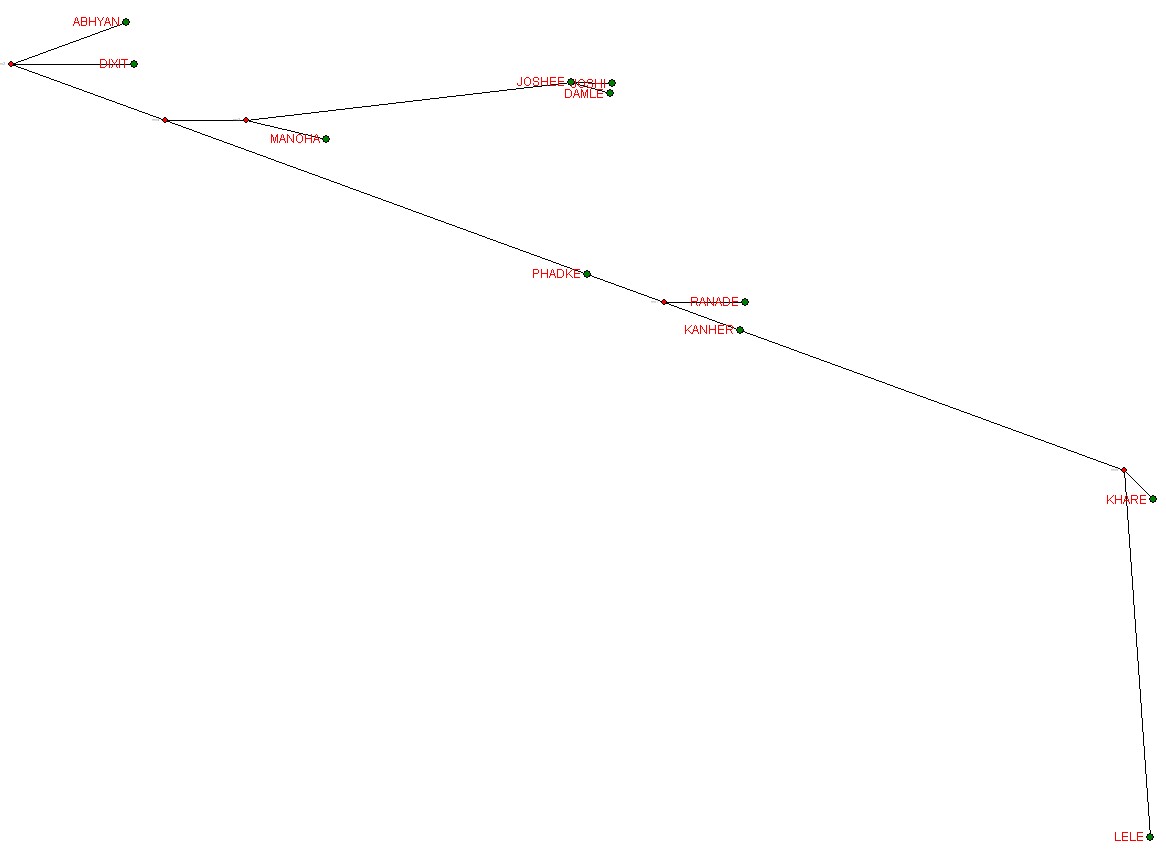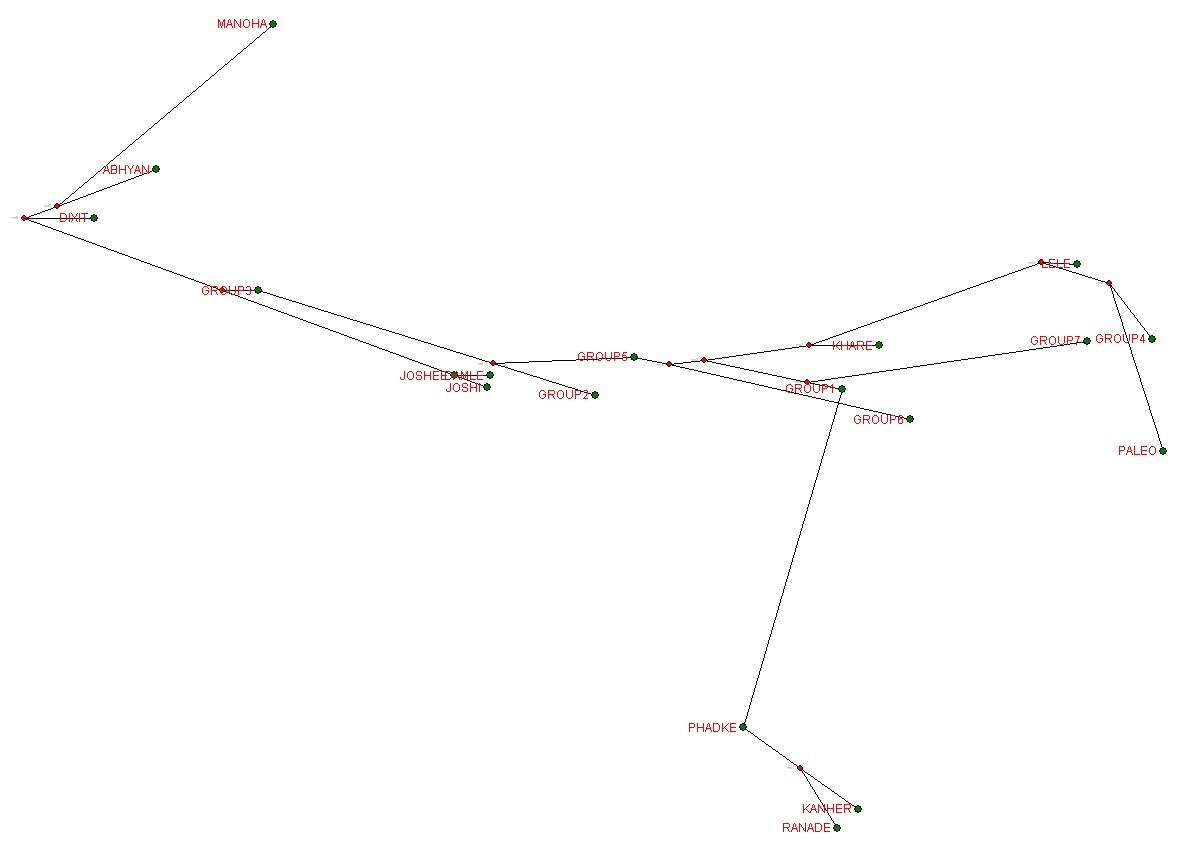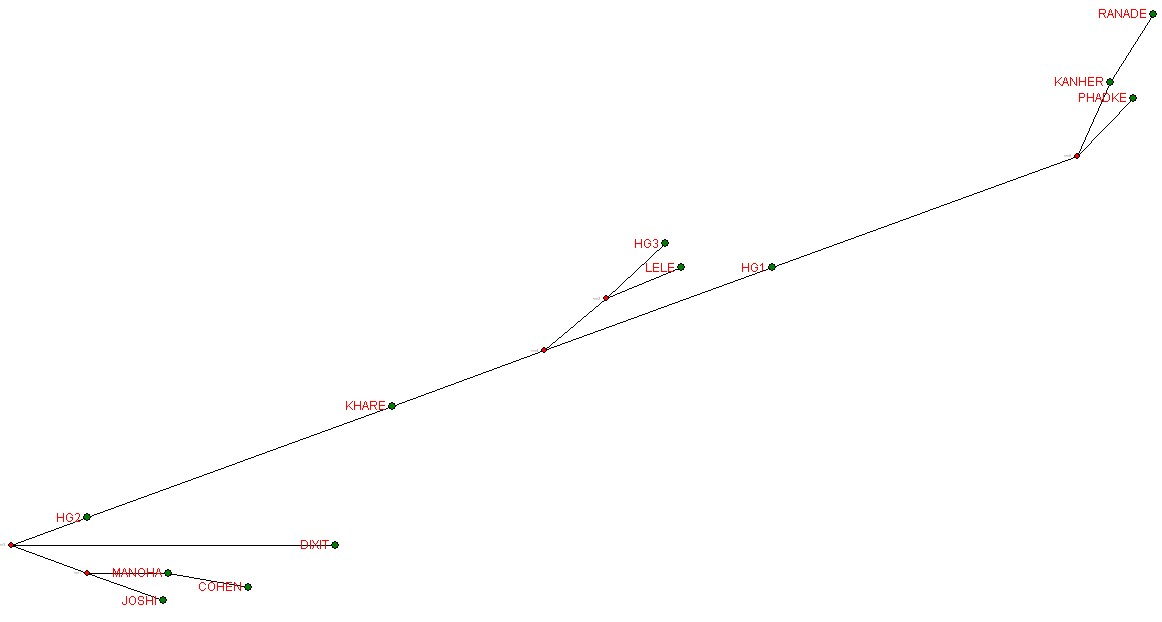
L. David Roper (roperld@vt.edu)
(www.roperld.com)
I have compared the 25 Y-chromosome markers for 60 families, in which I identified a paleolithic group of families and a smaller neolithic group of families. I extended that analysis to define four different neolithic groups. Here I expand the comparison by including six sets of Y-chromosome 12-markers for the Asian Indian surname Chitpavan. (I am grateful to Jagannath Dixit, M.D. for providing these data to me.)
A way to look at the results is through a phylogenetic network. I use the free software of Fluxus Engineering (http://www.fluxus-engineering.com/sharenet.htm) to calculate and draw a network. (There are usually several possible networks for any given set of markers, but I present only the simplest looking one calculated by the program.) The phylogenetic network diagram is a visual way to see the genetic distances or relative mutations among the participants.
| Name/Allele (prefix DYS) |
393 | 390 | 19 | 391 | 385a | 385b | 426 | 388 | 439 | 389-1 | 392 | (389-2)- (389-11) |
| Dixit | 14 | 23 | 14 | 10 | 13 | 19 | 12 | 12 | 12 | 14 | 10 | 17 |
| Abhyankar | 14 | 23 | 14 | 10 | 14 | 20 | 12 | 12 | 10 | 13 | 10 | 16 |
| Phadke | 11 | 22 | 14 | 10 | 14 | 16 | 11 | 12 | 13 | 12 | 13 | 16 |
| Kanhere | 11 | 22 | 14 | 11 | 13 | 16 | 11 | 12 | 12 | 12 | 14 | 16 |
| Joshi | 12 | 24 | 14 | 10 | 18 | 18 | 11 | 14 | 12 | 14 | 11 | 16 |
| Damle | 12 | 24 | 14 | 10 | 18 | 19 | 11 | 14 | 13 | 14 | 11 | 16 |
| Ranade | 11 | 21 | 14 | 11 | 14 | 16 | 11 | 12 | 13 | 13 | 14 | 16 |
| Manohar | 12 | 23 | 14 | 10 | 14 | 19 | 11 | 15 | 11 | 13 | 11 | 18 |
| Joshee | 12 | 24 | 14 | 10 | 18 | 19 | 11 | 14 | 12 | 14 | 11 | 16 |
| Khare | 13 | 22 | 15 | 11 | 13 | 14 | 11 | 12 | 12 | 12 | 11 | 19 |
| Lele | 13 | 25 | 15 | 11 | 11 | 14 | 12 | 12 | 11 | 13 | 10 | 18 |
One should subtract 389-1 from 389-2 before calculating relative mutations or calculating phylogenetic networks. If one does not do this one can get either one too many or one too few relative mutations.
The relative mutations among these individuals are:
| Relative Mutations |
Dixit | Abhyankar | Phadke | Kanhere | Joshi | Damle | Ranade | Manohar | Joshee | Khare |
| Dixit | 0 | |||||||||
| Abhyankar | 6 | 0 | ||||||||
| Phadke | 16 | 16 | 0 | |||||||
| Kanhere | 16 | 18 | 4 | 0 | ||||||
| Joshi | 14 | 16 | 16 | 18 | 0 | |||||
| Damle | 14 | 16 | 16 | 20 | 2 | 0 | ||||
| Ranade | 18 | 18 | 4 | 4 | 18 | 18 | 0 | |||
| Manohar | 11 | 11 | 15 | 17 | 11 | 11 | 17 | 0 | ||
| Joshee | 13 | 15 | 17 | 19 | 1 | 1 | 19 | 10 | 0 | |
| Khare | 15 | 19 | 13 | 11 | 21 | 23 | 15 | 16 | 22 | 0 |
| Lele | 15 | 17 | 21 | 19 | 23 | 25 | 21 | 18 | 24 | 10 |
Another way to look at the results is through a phylogenetic network. I use the free software of Fluxus Engineering (http://www.fluxus-engineering.com/sharenet.htm) to calculate and draw a network. (The official brief instructions for using the program are at http://www.fluxus-engineering.com/netwinfaq.htm. I have some further instructions at Brief Instructions for Using the Phylogenetic Network Program)(There are usually several possible networks for any given set of markers, but I present only the simplest looking one calculated by the program.) The phylogenetic network diagram is a visual way to see the genetic distances or relative mutations among the participants.
A phylogenetic network for these individuals is:
 |
| Note that there are four groups of hitpavans. |
Another way to visualize the relationships among the testees is by time-ordered (rooted tree) phylograms calculated from relative-mutations matrices. To create time-ordered phylograms, I use the PHYLIP Neighbor software, with the UPGMA option (Unweighted Pair Group Method with Arithmetic Mean), and the relative-mutations matrix to generate a tree file (*.tre) to be plotted by the TreeView software. (For a description of how I do it, see PHYLIPTreeViewUse.htm.) Here is a phylogram for the Chitpavans:
 |
| Note the scale in the lower left corner: The distance shown is 0.1 relative mutations. For long times for 12 markers, 1 relative mutation is about 1000 years, assuming a generation is 25 years and the average mutation rate is 1/500 per marker [(500 gen/mutation)·(25 years/gen)/(12 markers)~=1000 years]. The extreme right is the present time. Do not use this calculation for short times, because a single mutation can occur in 1 generation or 25 years. |
To compare the six Chitpavans to the European groups (See Neolithic Groups of Humans and Defining an Ancient European Ancestor), look at the relative mutations:
| Relative mutations |
Paleolithic Median |
Neolithic Group 1 |
Neolithic Group 2 |
Neolithic Group 3 |
Neolithic Group 4 |
Neolithic Group 5 |
Neolithic Group 6 |
Neolithic Group 7 |
| Dixit | 15 | 16 | 13 | 9 | 16 | 14 | 16 | 13 |
| Abhyankar | 17 | 14 | 15 | 11 | 18 | 14 | 18 | 15 |
| Phadke | 13 | 10 | 15 | 17 | 18 | 12 | 14 | 13 |
| Kanhere | 11 | 12 | 17 | 19 | 18 | 14 | 18 | 13 |
| Joshi | 19 | 14 | 15 | 9 | 22 | 18 | 16 | 11 |
| Damle | 21 | 16 | 17 | 9 | 24 | 20 | 16 | 13 |
| Ranade | 13 | 14 | 17 | 19 | 20 | 16 | 16 | 15 |
| Manohar | 20 | 11 | 12 | 10 | 19 | 11 | 13 | 10 |
| Joshee | 20 | 15 | 16 | 8 | 23 | 19 | 17 | 12 |
| Khare | 12 | 9 | 14 | 16 | 13 | 7 | 9 | 12 |
| Lele | 8 | 15 | 16 | 18 | 5 | 13 | 13 | 14 |
;This phylogenetic network compares the six Chitpavans to the paleolithic group and neolithic groups:
 |
| Note that some of the Asian Indian families are more closely related to a European group than they are to the other Asian Indian families. |
Note that, although Lele has fewer relative mutations with the paleolithic group, the phylogenetic network shows it closer to neolithic Group 4.
Here are the relative mutations for the unique testees with four standard haplogroups:
| Haplogroups (prefix DYS) |
388 | 393 | 392 | 19(394) | 390 | 391 | Relative mutations with hg 1, 1.15+ |
Relative mutations with hg 2, 2,47+ |
Relative mutations with hg 3, 3.65+ |
Relative mutations with Cohen hg |
| hg 1, 1.15 | 12 | 13 | 13 | 14 | 24 | 11 | 0 | 7 | 5 | 9 |
| hg 2, 2.47 | 14 | 13 | 11 | 14 | 22 | 10 | 7 | 0 | 8 | 4 |
| hg 3, 3.65 | 12 | 13 | 11 | 16 | 25 | 11 | 5 | 8 | 0 | 10 |
| Cohen hg | 16 | 12 | 11 | 14 | 23 | 10 | 9 | 4 | 10 | 0 |
| Dixit | 12 | 14 | 10 | 14 | 23 | 10 | 6 | 5 | 7 | 7 |
| Abhyankar | 12 | 14 | 10 | 14 | 23 | 10 | 6 | 5 | 7 | 7 |
| Phadke | 12 | 11 | 13 | 14 | 22 | 10 | 5 | 6 | 10 | 8 |
| Kanhere | 12 | 11 | 14 | 14 | 22 | 11 | 5 | 8 | 10 | 10 |
| Joshi | 14 | 12 | 11 | 14 | 24 | 10 | 6 | 3 | 7 | 3 |
| Damle | 14 | 12 | 11 | 14 | 24 | 10 | 6 | 3 | 7 | 3 |
| Ranade | 12 | 11 | 14 | 14 | 21 | 11 | 6 | 9 | 11 | 11 |
| Manohar | 15 | 12 | 11 | 14 | 23 | 10 | 8 | 3 | 9 | 1 |
| Joshee | 14 | 12 | 11 | 14 | 24 | 10 | 6 | 3 | 7 | 3 |
| Khare | 12 | 13 | 11 | 15 | 22 | 11 | 5 | 4 | 4 | 8 |
| Lele | 12 | 13 | 10 | 15 | 25 | 11 | 5 | 8 | 2 | 10 |
This phylogenetic network compares the unique Chitpavan testees to the four haplogroups:
 |
| Joshi & Manoha are in the Cohen group. Lele is in the hg3 group. |
We see that the testees are in neither of these four haplogroups.
For a information about haplogroups see: ;http://freepages.genealogy.rootsweb.com/~dgarvey/DNA/RelGen/YCC.html; http://www.pnas.org/cgi/reprint/98/9/5078.pdf; http://freepages.genealogy.rootsweb.com/~dgarvey/DNA/RelGen/6markers.html